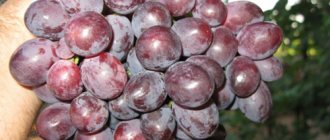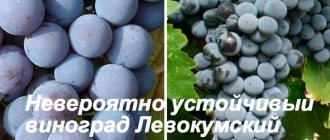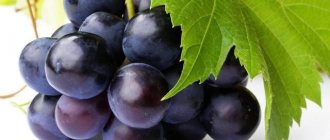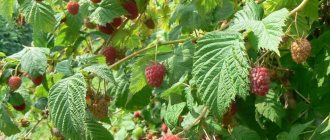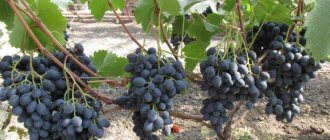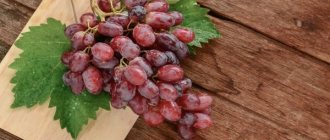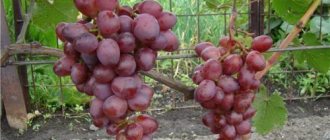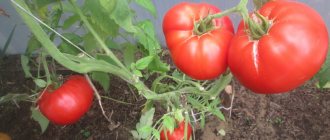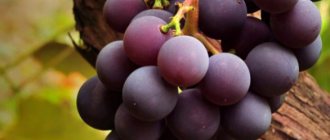Fruits and berries » Grapes
0
791
Article rating
Kira Stoletova
Grapes are a perennial crop that grows in the form of a bush. It is grown independently to produce berries, which are processed into juices and wines, and also consumed fresh. Magaracha grapes are a popular early variety due to their good yield.
Early grapes Magaracha
Magaracha grapes: variety description
Magaracha grapes will ripen quite quickly. From the moment the rudiments appear until the variety fully ripens, no more than 120 days pass. In this case, the fruits are fully formed, as a rule, by the end of August. Although you can start enjoying them somewhere in the middle of the last summer month.
It is best to form a bush in the image of a standardless three-armed fan. Because this is how it will grow best. It will also reduce the risk of diseases due to excessive crowding of the leaf part.
But it is still worth considering the landing area. If planting is carried out in the south, where there is an excess of sunlight and heat, then the plant can be formed in the form of a regular trunk. In this case, the height of the plant can be more than 1 m. And in any case, it will need support. Because a shapeless bush may encounter diseases. Which will have an extremely negative impact on its future productivity.
Advantages and disadvantages
The variety has good survival rate in regions without strong changes in seasonal temperatures; it can withstand temperatures down to -18 C. The advantages of the variety include:
- high yield rates;
- stability of fruiting;
- versatility of use.
At the same time, Early Magaracha is quite demanding on the quality of the soil and the sufficiency of heat, so it cannot be called unpretentious . Fruit ripening is only possible if the total temperature is 2,300 C, which imposes a limitation on possible regions for cultivation.
Grape pruning
In spring, the grape bush must be pruned. To do this, leave no more than 8 eyes on the branches. But it all depends on the condition of the plant after winter. One bush should not have more than 40 buds. Otherwise, the harvest will be very abundant. But weak and tasteless. Because the plant will need to give nutrients to all the many remaining buds.
Features of planting and care
- To get good yields of Magaracha Citron grapes, you need to think about proper planting. The place should be sunny and protected from the cold north wind. It is best to plant bushes on a private plot on the south or south-east side of buildings.
- The Magaracha Citron variety requires fertile, well-drained soil. Watering should be plentiful, but the water should not stagnate, otherwise the roots will begin to rot.
- Before planting, add lime or wood ash to the loamy soil. Repeated feeding is carried out after a year. The planting hole must be voluminous, at least 60 cm deep, so that the roots have room. When planting, you need to pay attention to the root collar; it should be buried 5 cm. Plantings should be watered generously. The step between seedlings is about 2 meters.
- They feed the grape bushes in the spring and add rotted manure. Before the flowers bloom, you need to water them. During flowering and when the grapes are filling, watering is not recommended: the bushes drop their flowers and the berries crack.
- The Citron Magaracha grape variety does not need to be overloaded with extra branches; it is demanding on timely pruning. As a rule, bushes are formed in the form of a four-armed fan, and the sleeves themselves are pruned into 8-10 buds. For abundant fruiting, leave no more than 30 eyes on the bush. All work is carried out in the fall after the leaves have been shed and the vines have ripened. The shoots that bear fruit and those directed towards the middle of the bush are subject to pruning.
- There is no point in relying on the fact that, according to the description and characteristics, the Magaracha Citronny variety is resistant to grape diseases. Especially if you also have bushes of other varieties growing. Preventative treatments must be carried out several times during the growing season.
- In addition to diseases, the Magaracha Citron and Kishmish Citron grapes are threatened by wasps and birds. They really like sweet berries. It is recommended to cover the plantings with a net or hide each bunch in a bag, as in the photo below.
- And one last thing. After processing, fertilizing and pruning, the grapevine is covered for the winter when temperatures drop (-5 - -10 degrees).
Where to grow Magaracha grapes?
Magaracha grapes are excellent for growing in the southern part of the Crimean Peninsula. This region, as a rule, is considered almost the most universal when we talk about growing grapes. It also has a very attractive soil composition. The grapes feel great and get sick less often. It also gives a bountiful harvest.
This variety is very wary of sudden cold snaps. Therefore, it should be planted in certain areas. Where the weather remains warm. Because the level of winter hardiness of the variety is very low.
The soil for growing grapes should be light and warm. And also as comfortable as possible for the growth of grape crops. It is best to form a culture closer to the ground. And there should be no more than 20-25 shoots on the bush. In this case, it will not be overly thickened.
Aftercare for grapes
After planting the grapes, the cultivation technology does not differ from other varieties of the species. It is necessary to fertilize with fertilizers containing potassium before flowering, and again during fruit ripening.
Grape pruning
Pruning of grapes is carried out after the leaves have been shed, when sap flow has stopped, around the beginning of November. All side shoots are removed, the 3 strongest ones with 8 fruit buds are left, the rest are cut off. Events are held every year.
The variety is sweet, tasty and aromatic - these features attract birds and wasps. If you do not take action, you can lose most of the harvest. The following devices are recommended at home:
- Each bunch is covered with a net with small cells:
- special ratchets are installed;
- a tape is hung between the bushes; it flutters in the wind and scares away birds and insects;
- a scarecrow is installed, plastic bags are attached to the bushes, making noise.
Bioacoustic devices are placed in large areas of industrial cultivation. Toxic baits are hung from wasps and insect nests are destroyed.
After pruning, the grapes are removed from the trellis, watered generously, and placed. Arcs equipped with moisture-impervious material are stretched over the straw from above. If a drop to -25 °C is expected, the vine is covered with a layer of soil. To preserve grapes from rodents, “Foret” grain bait is laid out near each bush, and “Muxidan” glue is also used, according to the instructions.
Harvest characteristics
Speaking about the density of the grape bunch, it should be borne in mind that it can vary depending on weather conditions. And also depending on the conditions that develop in the growing area of the Magaracha grape variety.
The bunch can be very rich. Its length, as a rule, reaches 20 cm, and its width is more than 15 cm. It is quite dense. Abundant with tasty and juicy berries. The brush can also be spreading and winged. And not too dense.
In less favorable regions, the brushes turn out to be completely loose and fragile. Berries are located on them quite rarely. The weight of one brush, which grows in the most suitable conditions, as a rule, can reach 0.5 kg. And the length of the leg varies from 3 to 4 cm.
Magaracha grapes: description of berries
The berries can ripen and become much larger than their average size. They have an oval or round shape. As for the color, it is quite standard. Namely: dark blue. Has a very strong waxy coating. Getting rid of it when washing is quite problematic.
The weight of one berry varies from 3 to 4 grams. One berry contains approximately 3 large seeds. The skin of the berries is quite thin. But at the same time very durable. For this reason, the berries tolerate long periods of storage and transportation quite well.
The pulp has a very pleasant taste. Consists of pink juice. The density of the pulp also differs in strength. Therefore, the berries can actually be transported. They don't suffer from it at all.
Taste characteristics of the variety
The taste of the berries may vary depending on the areas and climatic conditions in which the variety grows. As a rule, the berries are all distinguished by the fact that they have a very fresh aroma. They can be consumed fresh. And also for preparing various jams, preserves, desserts, and drinks. The variety is also suitable for making homemade wine.
Magaracha grapes: description of external qualities
The plant at an even earlier, young age is distinguished by the fact that it has spreading stems. Bronze leaves. They lighten over time. Becomes fresh green. As the plant gets older, it becomes larger. The vine also becomes more powerful. Because it needs to withstand a large number of berries. And this requires additional strength.
Ripened shoots have a light brown tint. And the nodes take on a dark, brown color. In autumn, the leaves turn from rich green to yellow. With bright red splashes. They are distributed in the form of spots over the entire surface of the leaf.
A flower of both sexes - both male and female. Therefore, the plant does not need additional fertilization. The growth of the variety is on average about 80%. This is quite a large figure. But, again, it is extremely important to take into account external conditions. And the fact that the plant, as a rule, needs additional care. There is no way to do without this.
Advantages of the variety
As we have already indicated, the variety has a fairly high yield level. A very different number of brushes can form on the stems. This depends solely on whether all the shoots will develop and bear fruit well. Or some of them will not do this.
Fertility also depends on external climatic conditions. And also on how the gardener himself will care for the plant. As a rule, from 1 hectare of land you can harvest a crop whose weight varies from 120 to 200 centners and more.
If there is a drought and there is no precipitation, then at this time the quality of the berries themselves may noticeably decrease, and in order to prevent this from happening, it is best to increase the volume of watering. It is also important not to let the berries ripen while still on the bush, as this can negatively affect the taste of the fruit. In addition, this can lead to the fact that the berries may simply fall off the bush. Again, the gardener must regularly inspect the plant, assess its general condition, possible deformations or negative manifestations.
Planting seedlings
Before planting, the cuttings are soaked in water for 48 hours for rooting. Several small cuts are made on the lower part at the base for better rooting. The upper part is immersed in paraffin at a temperature of +75 C, which will retain moisture. Next, the shoot is placed in a growth stimulator to increase its ability to root.
The shoot is planted in a container with fertile soil, moistened and sent under a greenhouse.
Landing dates
Cuttings stored during the winter are taken out 3 weeks before the planned planting and the rooting procedure is carried out.
Technology of planting in open ground
Planting is carried out in previously prepared soil. You need to choose a sunny place, not exposed to gusts of wind. A 50 cm depression is formed, fertilizer is applied, watered abundantly and then the seedling is planted. There should be a distance of 1.7-2.2 m between two adjacent bushes.
Magaracha grapes: diseases and pests
Despite everything, this variety is distinguished by its resistance to various diseases. But even at a young age, seedlings can be affected by phylloxera, as well as downy mildew. But considering that the variety is early ripening, this is a huge plus, since the berries are not at all afraid of gray rot. One way or another, to avoid fungal or viral diseases, you must choose either American or French seedlings. This choice is due to the fact that they are less susceptible to various diseases.
To combat spotting on shrubs, you can use professional products. Among them, experienced gardeners especially highlight products such as Thanos, Topaz or DNOC. The choice of drug directly depends on the time at which the symptoms of the disease appeared and how quickly it was detected on the plant. In general, despite many positive characteristics, the variety is distinguished by its capriciousness and whimsicality. Insects and pests, wasps and ants are very partial to it, and they also need to be dealt with regularly, as they can provoke various diseases.
Overall, the variety is suitable enough to be grown in warm areas. The variety is very early, the berries are of excellent taste and pleasant appearance. Of course, some effort should be made to get enough harvest, which will differ not only in external and taste characteristics, but which will also be stored for a long time and can easily be transported over long distances. In general, there are a large number of positive reviews for this variety, and gardeners continue to recommend it to everyone who is looking for an original, but at the same time universal variety, the fruits of which can be eaten fresh, or can be used to prepare dishes and drinks. The variety is suitable for growing in warm regions; in the middle zone there is a low probability that it will take root.
Cognac laboratory
Daria grapes: description and characteristics of the variety, rules of cultivation and care with photos
The cognac laboratory as a separate structural unit was organized as part of the winemaking technology department in April 1974. Currently, the laboratory continues to conduct scientific research in many areas, the main of which are:
- expansion of the raw material base for cognac production, including the study of new grape varieties that are resistant to adverse environmental factors, as well as improving the technology of cognac wine materials using modern technological equipment;
- improving the technology for producing cognac spirits using various types of devices in order to improve the quality of young cognac spirits, reduce material and energy costs, as well as increase the yield of high-quality alcohols;
- development of ways to accelerate the maturation of cognac spirits in order to improve quality and reduce losses during long-term aging;
- stabilization of finished products against cloudiness based on the study and elimination of clouding factors at all stages of cognac preparation.
The Cognac Laboratory works closely with leading enterprises and institutions of the wine industry in various areas:
- development of regulatory documentation for cognac production (standards, basic production rules, technological instructions, technical conditions) for the industry as a whole or individually for individual enterprises;
- development of new or transfer of already developed technologies at various stages of the cognac production process (improving the technology for obtaining cognac wine materials, improving distillation processes, improving and introducing new methods for accelerated maturation of cognac spirits, improving technologies for the preparation of blending materials to increase the stability of the finished product);
- recommendations on the selection of grape varieties, technological equipment, auxiliary materials, development of new brands of cognacs and spirits;
- recommendations for processing cognac blends. Study and elimination of clouding factors at all stages of cognac preparation.
